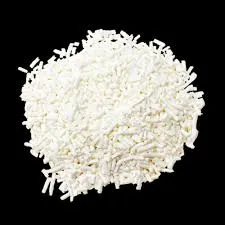
Properties and Applications of Polybutadiene Rubber in Modern Industries
An Overview of Poly Butadiene Rubber Properties, Applications, and Innovations
Polybutadiene rubber (PBD) is a synthetic rubber that belongs to the family of elastomers, specifically characterized by its high resilience and excellent abrasion resistance. As a polyolefin, PBD is derived from the polymerization of butadiene, a colorless gas that is a byproduct of petroleum refinement.
Properties of Poly Butadiene Rubber
The unique properties of polybutadiene rubber make it a material of choice for a variety of applications. One of its most noteworthy features is its high resistance to wear and tear, making it exceptionally durable. PBD also boasts an excellent low-temperature performance, enabling it to maintain flexibility in extremely cold environments. This attribute is particularly valuable in applications that require materials to perform under harsh conditions.
Moreover, polybutadiene rubber exhibits a good balance between hardness and elasticity, a characteristic that is essential in many industrial applications. Its low glass transition temperature allows it to remain flexible even at sub-zero temperatures. The lack of polar groups in its chemical structure contributes to its low absorption of moisture and oils, further enhancing its utility in certain environments.
Manufacturing Process
The production of polybutadiene rubber involves several methods, primarily utilizing anionic polymerization techniques. This process dictates the molecular weight and structure of the polymer, which in turn affects its physical properties. Depending on the desired characteristics, manufacturers can manipulate the polymerization conditions to produce various grades of PBD. Transitioning from solution-based to emulsion-based processes has also emerged as a significant development in the manufacturing of PBD, leading to improved control over the rubber's properties.
Applications of Poly Butadiene Rubber
poly butadiene rubber

Thanks to its impressive physical properties, polybutadiene rubber finds extensive applications in various industries. One of the primary uses of PBD is in the automotive sector, particularly for tire manufacturing. Polybutadiene is incorporated into tire compounds to enhance their durability and performance. Its high resilience and low rolling resistance contribute to improved fuel efficiency and safety in vehicles.
In addition to tires, PBD is often used in rubber products, including seals, gaskets, and conveyor belts. Its excellent abrasion resistance makes it ideal for applications where friction and wear are significant concerns. Moreover, because of its flexibility and elasticity, polybutadiene rubber is also utilized in sporting goods and household items, such as footwear and mats.
Additionally, the use of PBD is not limited to traditional applications. The rise of modern technology has led to its incorporation into advanced materials. Polybutadiene-based composites are gaining popularity in industries such as aerospace and electronics, where performance and reliability are critical.
Innovations in Poly Butadiene Rubber
As with many materials, research and development are pivotal in enhancing the properties and functionalities of polybutadiene rubber. Innovations in polymer chemistry have led to the development of modified versions of PBD that imbue the rubber with additional properties, such as improved thermal stability and enhanced adhesion capabilities.
Green chemistry initiatives have also influenced the production approaches for PBD. Efforts to develop bio-based alternatives and recycle synthetic rubbers are underway, addressing environmental concerns associated with traditional rubber manufacturing. These advancements not only aim to reduce the ecological footprint of PBD but also enhance its marketability in a world increasingly focused on sustainability.
Conclusion
Polybutadiene rubber is a remarkable material with a wide array of applications and properties that cater to many industrial needs. Its durability, flexibility, and resistance to abrasions make it essential in various sectors, particularly the automotive industry. With ongoing innovations and a focus on sustainable practices, the future of polybutadiene rubber appears bright, promising advancements that could further enhance its utility and relevance in the evolving technological landscape. As industries continue to seek high-performance materials, polybutadiene rubber will undoubtedly play a pivotal role in shaping the future of synthetic elastomers.
-
Understanding Synthetic Rubber OptionsNewsApr.27,2025
-
Trichloroisocyanuric Acid: Essential for Clean and Safe WaterNewsApr.27,2025
-
Sodium Dichloroisocyanurate: Key to Safe Water TreatmentNewsApr.27,2025
-
Sodium Acid Pyrophosphate: Essential in Modern Food ProcessingNewsApr.27,2025
-
Essential Water Treatment ChemicalsNewsApr.27,2025
-
Denatured Alcohol and Its Industrial UsesNewsApr.27,2025
-
The Versatile Uses of Sodium BicarbonateNewsApr.24,2025
Hebei Tenger Chemical Technology Co., Ltd. focuses on the chemical industry and is committed to the export service of chemical raw materials.
-

view more DiethanolisopropanolamineIn the ever-growing field of chemical solutions, diethanolisopropanolamine (DEIPA) stands out as a versatile and important compound. Due to its unique chemical structure and properties, DEIPA is of interest to various industries including construction, personal care, and agriculture. -

view more TriisopropanolamineTriisopropanolamine (TIPA) alkanol amine substance, is a kind of alcohol amine compound with amino and alcohol hydroxyl, and because of its molecules contains both amino and hydroxyl. -

view more Tetramethyl Thiuram DisulfideTetramethyl thiuram disulfide, also known as TMTD, is a white to light-yellow powder with a distinct sulfur-like odor. It is soluble in organic solvents such as benzene, acetone, and ethyl acetate, making it highly versatile for use in different formulations. TMTD is known for its excellent vulcanization acceleration properties, which makes it a key ingredient in the production of rubber products. Additionally, it acts as an effective fungicide and bactericide, making it valuable in agricultural applications. Its high purity and stability ensure consistent performance, making it a preferred choice for manufacturers across various industries.











